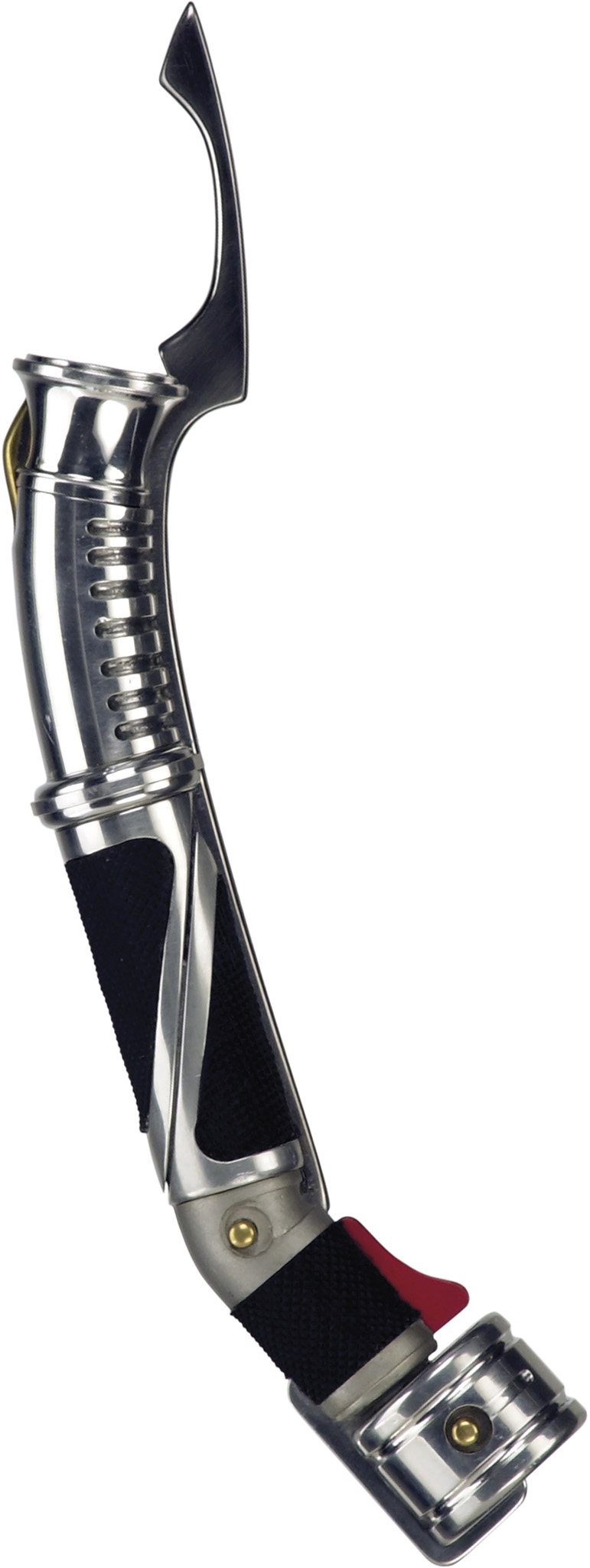g Republic Era g Contents
7
Sith Lightsabers
Location: Various
Date: c. 32 BBY
At first glance, one might mistake this hilt as the weapon of a Jedi. Look closely, however, and you will find a perversion of the light. This saber hides a corrupted kyber crystal made to bleed a sickly red.
Where the lightsabers of the Jedi were principally employed for defense, the nearly identical weapons of the Sith were made for destruction. This saberstaff, with its deadly dual blades, is a prime example of the devastation that could be wrought in the hands of pure evil.
Each Force-wielder who has built a lightsaber has constructed a unique artifact created to fit their personal aesthetic and fighting style. In some cases their lightsaber might pay homage to their species and ancestry. To the vast majority of beings across the galaxy who lacked Force-sensitivity, these laser swords, whether belonging to Jedi or Sith, could appear interchangeable.
In countless stories, the Sith and their followers were initially mistaken for keepers of the peace. As soon as people saw their blades blaze crimson, however, it was all too obvious that the Sith’s interests and intentions were totally opposed to those of the Jedi Knights.

Before Darth Vader and Count Dooku served Darth Sidious, another villain kneeled at his feet: Darth Maul. A Zabrak Nightbrother from the mists of Dathomir, Maul’s horn-headed visage was a fearsome sight. Yet his real power came from his preternatural agility and his skill with his double-bladed lightsaber.
On the besieged world of Naboo, Maul used this formidable weapon to murder the Jedi Qui-Gon Jinn before he, in turn, was felled by Jinn’s apprentice, Obi-Wan Kenobi. The duel ended when both Maul and his lightsaber were cleaved in two. The Sith Lord was widely believed to be dead, although his enemies subsequently learned that he had somehow survived, fueled by his burning desire for vengeance.
And what of his weapon? Although a Sith no longer after this crushing defeat, Maul reinvented himself several times over the ensuing years. Ultimately, he became one of the most powerful crime lords in the galactic underworld. This double-bladed lightsaber relates to a period in his youth when he served the Sith’s cause. For a brief time, Maul changed the course of history by killing the Jedi Knight who discovered—and would have trained—Anakin Skywalker.
After Maul’s presumed demise, Darth Sidious took a new pupil in Darth Tyranus. Earlier in life Tyranus was a ruler of Serenno known as the Jedi Master Dooku.
Dooku’s lightsaber had an elegantly curved hilt fashioned to complement his fighting style. Its grip is similar to that of a dueling blaster. He was known among those who sparred with him at the Jedi Temple as an especially skilled and agile opponent. Dooku’s superb dueling technique was comprised of precision moves, formal lunges, and ripostes, hardwired during his days training at the Jedi Temple.
The unusual design of Dooku’s lightsaber required a special degree of confidence and composure, lest an ungraceful move should result in an inadvertent injury to the wielder. Owing to many long hours of combat training in Dooku’s company, Asajj Ventress, his assassin, carried a matching set of lightsabers that imitated the curvature of her master’s hilt.
For nearly 50 years, through numerous twisted tales of subterfuge and corruption, these players had one thing in common: Sheev Palpatine. Operating in secret as the Sith Lord Darth Sidious, Palpatine was a veritable puppet master, controlling both galactic events and the backstabbing duplicity within his own ranks.
Palpatine could not openly carry his lightsaber without inviting suspicion, but he liked to keep it close at hand, hidden from view. It was sometimes sequestered in his beloved statue of Sistros, one of the Four Sages of Dwartii, or in various other hiding places in his office at the Coruscant Senate Building. The compact, 19-centimeter (7-and-a-half-inch) hilt was also easy to conceal among the billowing folds of his stately Chancellor robes. A sleek phrik base—a rare and robust alloy—made up the majority of the hilt, with aurodium caps on either end to add a stylish accent. Palpatine owned at least two identical blades, and was skilled at fighting with two sabers in combat against multiple assailants.

Darth Tyranus, also known as Count Dooku, carried this curved hilt, a design also reflected in the choices of his apprentice, Asajj Ventress.
It is a common refrain that only two Sith can operate at any given time—a master and an apprentice. This is due to the ruthlessness that is the very essence of the Sith’s philosophy. Once Sith apprentices become powerful enough, they invariably overpower their teachers, murdering their masters and taking their place. They then school a pupil of their own and the cycle begins again.
To become a Sith is to be inherently distrustful, conniving, and cruel. There is plenty of evidence that students and masters alike flouted the ritualistic “Rule of Two,” whether out of vengeance, ambition, or fear.
The lightsabers of the Sith, and the villainous creatures who employed them, are no longer a threat to the light. But these artifacts serve as a warning that the darkness is not easily dissuaded from its purpose: to snuff out all that is good in the galaxy. And morbid vengeance can be as potent as idealism in fueling a cause.

Palpatine liked to keep his compact lightsaber with its vibrant red blade nearby or on his person, but he rarely resorted to it. If trouble threatened, he preferred to project bolts of lightning from his fingertips, wounding opponents from a safe distance.